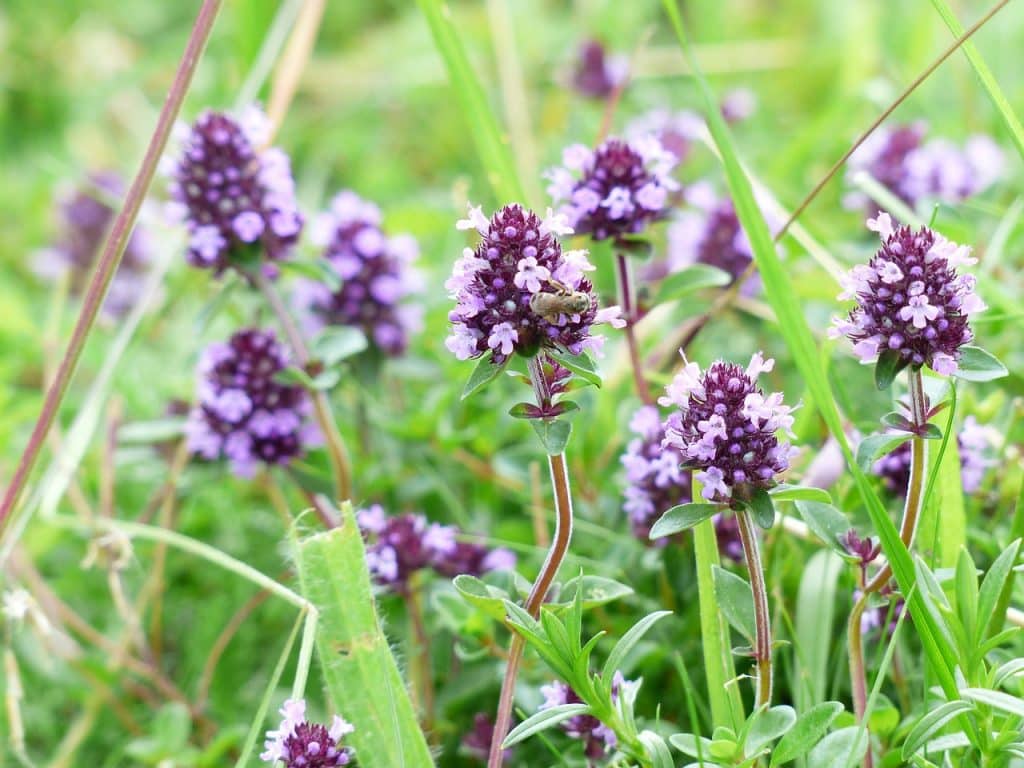Thyme
Thymus serpyllum diversae L.
Residence in Bulgaria::
In our country it is found from the lowlands to the high parts of the mountains, on dry, sunlit meadows and slopes, everywhere - from the sea coast to the snow lines of the high mountains
Description:
Perennial herb, no-rare semi-shrub, with creeping or decumbent, strongly branched, slightly woody at the base, four-ribbed, erectare flowering stems, 20–40 cm tall. Leaves are simple, entire, opposite, sessile or shortly petiolate, linear-lanceolate, ovate or elliptic, with point-like жлези and glandular hairs 2–6 mm long, 1–3 mm wide. The flowers are pink and red to white, located in the axils of the uppermost leaves, forming compact or interrupted globose, globose, spike or panicle inflorescences. The calyx is cylindrical or bell-shaped, double-lipped, with a wide 3-part upper and 2-part lower lip. The corolla is indistinct, bilobed, with an incised upper 3-lobed lip. The stamens are 4, protruding from the side of the upper lip. The ovary is superior. The fruit splits into 4 ovoid nutlets.
Usable parts:
The flowering aerial parts of the plant. Cut off with a sharp knife the entire leafy part 1–2 cm from the root, always during abundant flowering
Collection time:
May - August
Composition of the herb:
Thyme contains about 0.7 % essential oil with a strong, pungent, pleasant smell and fiery taste, which includes the cresol derivatives L-cymol, gamma-terpinene, beta-terpineol, zingiberene, paracymol, etc. The drug contains up to 8 % tanning substances, up to 55 mg of vitamin C, the bitter substance serpilin, resins, pigments, ursolic and oleinolic acids, the still unspecified flavonoid glycoside, etc.
Therapeutic effect::
Expectorant, nervine, antibacterial.
Usage:
Thyme is used in грип, cough, whooping cough, bronchitis, bronchial asthma, armorhopneumonia, stomach and abdominal pains, colitis, dropsy, gout, hemorrhoids, gas in the intestines. Inflammation of the middle ear. Headache, insomnia, neurasthenia, loss of appetite. It is also used for bruises, sprains, eczema, etc.
Ways of use:
Internally: 100 g of finely chopped drug is poured with 2 liters of boiling water, left to soak until it cools, then strained and drunk warm, 1 tablespoon every 2 hours. It can also be used in the form of a tincture of 70 % alcohol andthyme, in a ratio of 10:2, taking 20 drops in 50 ml of water, 3 times a day. The herb is not toxic.
Externally: It is used as a poultice to apply to bruises, sprains, wounds, eczema, inflammation of the facial nerve
Bulgarian traditional usage::
Tea from Thyme it is drunk at cough, stomach pain, indigestion, bad breath. The herb is particularly useful in nervous diseases, insomnia, fears and apprehension. Thyme is applied as immobilizing bandages for broken, cracked and sprained wounds. Recommended for red wind, women's diseases, жлези, пясък в бъбреците. При болки в очите се прави парна баня от равни количества Thyme and Ravnec. For toothache, gargle with a decoction of 8–10 stems Thyme and Black Oman roots. Decoction of Thyme and Savory is drunk instead of water during ochtika. Thyme is valued as a safe remedy for foot and mouth. A strong decoction of it is used to wash the wounds of sick animals.

